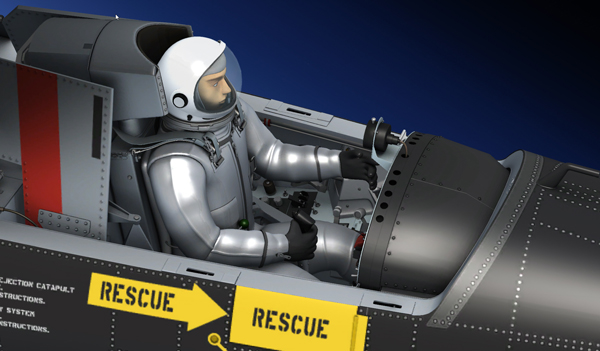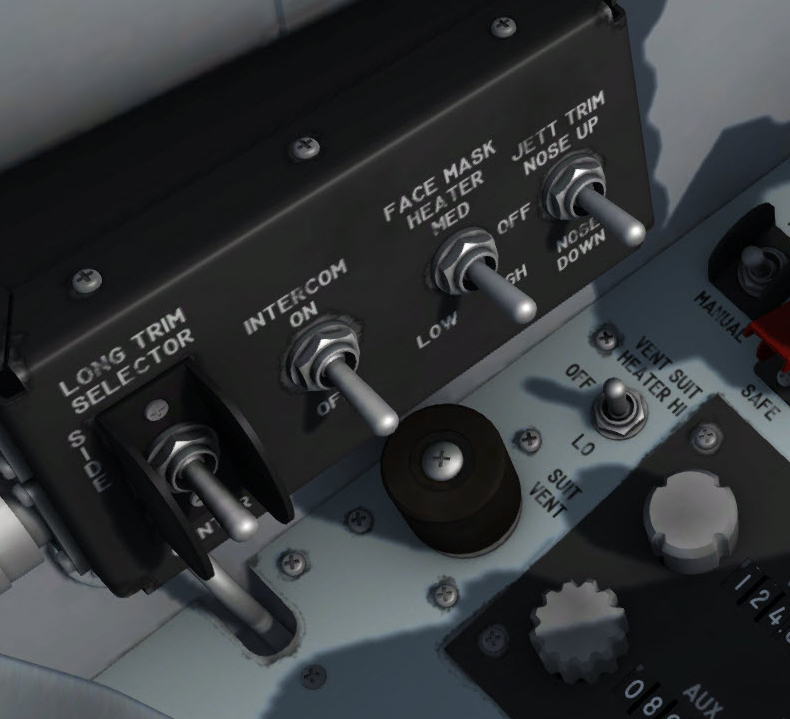
X-15 pilot wearing the David Clark A/P22S-2 full pressure suit.
The pilot's A/P22S-2 full-pressure suit is ventilated and pressurized by either the X-15 or the augmented cooling system liquid nitrogen supply.
The liquid nitrogen flows through a heat exchanger and flow restrictor, where it is converted to gaseous nitrogen, then through a check valve, an electrical heater, and then to the vent suit flow control valve. From the vent suit flow control valve, the gaseous nitrogen is routed through a flexible disconnect hose and coupling to the pressure suit.
After launch, ventilation of the pressure suit is maintained by the nitrogen system of the X-15 airplane. Suit pressure is maintained at 1/10 psi above cockpit pressure at all altitudes above 35,000 feet. If cockpit pressure should fall, the nitrogen supply will pressurize the suit to maintain the 35,000-foot environment. The same routing lines and controls are used whether the nitrogen comes from the carrier airplane or the X-15.
The desired volume of flow can be controlled from the cockpit. Temperature of the gaseous flow to the pressure suit may be controlled from approximately 50° F to 90° F by the vent suit gaseous heater. The heater is of the electric-tubular type and is controlled from the cockpit. Pressure and ventilation to the pressure suit are maintained automatically up to the vent suit flow control valve, when the air conditioning and pressurization system is in operation, by either the carrier airplane or the X-15 nitrogen system.
The pressure suit is equipped with a pressure regulator that is used for suit ventilation, and an anti-blackout pressure regulator that operates from the breathing oxygen supply. In addition to these provisions, the suit back pan also contains a demand-type oxygen regulator for normal and emergency use and a stored supply of oxygen to be used during emergency ejection.
An integrated parachute harness and restraint assembly also forms a part of the pressure suit.

Pressure suit controls on the left console.
A knob [5, fig. 5-4], on the left console, controls the flow of gaseous nitrogen to the pressure suit. This knob, marked "PRESS. SUIT VENT", has an arrow to indicate the direction the knob should be turned (counterclockwise) to increase the volume and flow of the nitrogen to the suit.
The knob has direct mechanical linkage to the flow control valve. Nitrogen flow is restricted to 7 cubic feet per meter by a stop on the knob. This is to prevent excess nitrogen flow which could override the capabilities of the vent suit heater in addition to causing suit over-pressurization. The 7 cfm provides sufficient ventilating gas flow for normal conditions. When initiating suit ventilation, the knob should be opened about one turn and then the vent suit heater switch [6, fig. 5-4] should be moved to either HIGH or LOW, as required. If additional ventilation is required, the knob can be opened further.
The vent suit heater switch [6, fig. 5-4], on the left console, is a three-position switch. The switch is powered by the primary DC bus. The heater is powered by the primary AC busses.
With the switch in the HIGH position, the gaseous nitrogen to the vent suit is heated to a temperature of approximately 75° F to approximately 90° F and is maintained within that range by a thermoswitch.
With the switch in the LOW position, another thermoswitch maintains a temperature of approximately 55° F to approximately 70° F.
With the switch in the OFF position, the heater is inoperative, and the temperature of the gaseous nitrogen is that of the system temperature.
Primary DC bus power for the helmet visor heat elements is controlled by a four-position switch [3, fig. 5-4], on the left console. The switch is labeled "FACE MASK HTR".
The face mask heater is energized when the switch is moved from OFF. Heat is increased as the switch is moved from the LO to the MED and HI positions.
See also:
Air Conditioning and Pressurization System